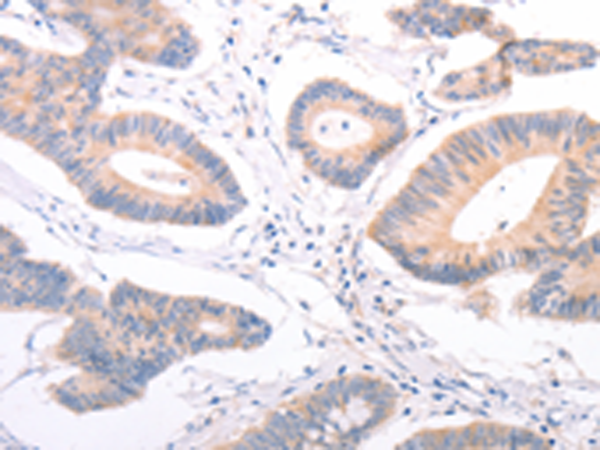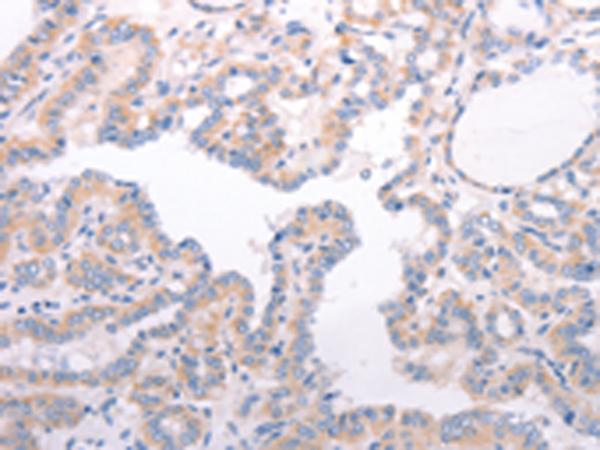

| WB | 咨询技术 | Human,Mouse,Rat |
| IF | 咨询技术 | Human,Mouse,Rat |
| IHC | 1/50-1/200 | Human,Mouse,Rat |
| ICC | 技术咨询 | Human,Mouse,Rat |
| FCM | 咨询技术 | Human,Mouse,Rat |
| Elisa | 1/5000-1/10000 | Human,Mouse,Rat |
| Aliases | FIX; P19; PTC; HEMB; THPH8 |
| Host/Isotype | Rabbit IgG |
| Antibody Type | Primary antibody |
| Storage | Store at 4°C short term. Aliquot and store at -20°C long term. Avoid freeze/thaw cycles. |
| Species Reactivity | Human, Mouse, Rat |
| Immunogen | Fusion protein of human F9 |
| Formulation | Purified antibody in PBS with 0.05% sodium azide and 50% glycerol. |
+ +
以下是关于TGFB1抗体的3篇参考文献(示例为模拟内容,非真实文献):
---
1. **文献名称**:*TGF-β1 signaling in cancer progression and immune regulation*
**作者**:Derynck, R. et al.
**摘要**:该研究系统分析了TGFB1在肿瘤微环境中的双重作用,并开发了一种特异性单克隆抗体(克隆号1D11),证实其可抑制TGFB1介导的肿瘤细胞侵袭和免疫抑制功能。
---
2. **文献名称**:*Neutralizing TGF-β1 antibody attenuates fibrosis in murine models of systemic sclerosis*
**作者**:VanHook, A. M. et al.
**摘要**:通过使用抗TGFB1中和抗体(克隆号9016),研究者在小鼠模型中成功阻断了纤维化通路,显著降低了皮肤和肺组织胶原沉积,为纤维化疾病治疗提供了实验依据。
---
3. **文献名称**:*Differential effects of TGF-β1 isoforms detected by antibody-specific ELISA assays*
**作者**:Smith, J. & Jones, M. L.
**摘要**:本研究比较了三种市售TGFB1抗体(如Abcam ab27969、R&D Systems MAB240)的检测特异性,发现不同抗体对激活型/潜活型TGFB1的识别差异显著,提示实验设计中抗体选择的重要性。
---
注:以上内容为示例,实际文献需通过PubMed或Web of Science等平台检索。建议使用关键词“TGFB1 antibody”“neutralizing antibody”“TGF-beta 1 detection”筛选近五年高被引论文。
TGFB1 (Transforming Growth Factor Beta 1) is a multifunctional cytokine belonging to the TGF-β superfamily, playing critical roles in cell proliferation, differentiation, apoptosis, immune regulation, and tissue homeostasis. Dysregulation of TGFB1 is implicated in various pathologies, including cancer, fibrosis, autoimmune diseases, and chronic inflammation. TGFB1 antibodies are essential tools for detecting, quantifying, or inhibiting TGFB1 activity in both research and therapeutic contexts.
As a research reagent, TGFB1 antibodies are widely used in techniques like Western blotting, immunohistochemistry, ELISA, and flow cytometry to study TGFB1 expression, localization, and signaling pathways. Therapeutically, neutralizing TGFB1 antibodies aim to block its immunosuppressive or profibrotic effects. For example, in cancer, TGFB1 promotes tumor progression and metastasis by suppressing antitumor immunity; antibodies targeting TGFB1 may enhance immunotherapy efficacy. In fibrotic diseases, such as liver or kidney fibrosis, TGFB1 antibodies can inhibit extracellular matrix deposition.
Despite their potential, challenges remain, including isoform-specific targeting (to avoid off-effects), managing TGFB1's dual roles (tumor-suppressive early vs. tumor-promoting late), and optimizing delivery. Clinical trials of TGFB1-targeting therapies (e.g., fresolimumab) have shown mixed results, underscoring the need for precise modulation. Ongoing research focuses on improving antibody specificity, combination therapies, and biomarker-driven patient stratification to maximize therapeutic benefits.
×